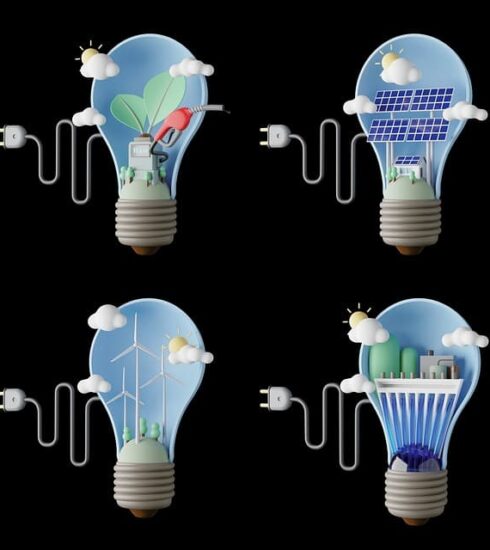A Greener Future Starts with a Transition from Coal to Alternative Energy Sources
As the global economy emerges from the COVID-19 crisis, coal consumption is expected to recover from the sharp decline that occurred in the wake of the pandemic.
Demand for coal remains strong and helps meet the economic development needs of emerging economies. Nevertheless, many countries seeking a more sustainable future are taking steps to reduce their dependence on fossil fuels-especially coal. Overcoming the obstacles facing countries is proving difficult, not least because people working in the coal industry depend on it for their main livelihoods; but using the right economic policy levers can help.
“Green” investments and technological advances can help curb the recovery in coal consumption levels and accelerate the transition to cleaner energy sources as economic activity normalizes. In addition, well-designed policies can ease the impact of this transition on coal miners and others whose incomes depend on coal production.
Background
Coal is a major source of local pollution and climate change, accounting for 44 percent of global carbon dioxide emissions. When burned to produce heat and electricity, coal’s carbon intensity is 2.2 times that of natural gas; this means that burning coal emits more than twice as much carbon dioxide as burning natural gas to produce the same amount of energy. Coal-fired thermal power plants release sulfur dioxide, nitrogen oxide, particulate matter, and mercury into the air, rivers, streams, and lakes. These emissions not only degrade the environment, but they have also been shown to pose a threat to human health: the Great Smog, which occurred in London in 1952 as a result of coal burning and diesel engine exhaust, killed 4,000 people, according to British government medical reports.
There is a strong correlation between the level of development and coal consumption, with middle-income countries generally most dependent on coal. During the second industrial revolution in the late 19th and early 20th centuries, reliance on coal increased rapidly in advanced economies. But as incomes continued to rise, coal was gradually supplanted by more efficient, more user-friendly, and less polluting fuels such as oil, nuclear power, natural gas, and, more recently, renewables.
The downward trend in coal consumption was interrupted in the 1970s, after which coal consumption recovered in part because of three important factors: 1) concerns about energy security, 2) growth in electrification, and 3) high rates of economic growth in emerging economies. The increase in electricity demand has contributed to the recovery of demand for coal in power generation in many advanced economies, which, in addition, have returned to using coal to reduce dependence on imported oil. By the beginning of this century, coal use had declined again in advanced economies, but this decline was more than offset by a surge in demand in emerging economies.
Emerging markets now account for 76.8 percent of global coal consumption, with China accounting for about 50 percent. Power generation accounts for 72.8 percent of coal use, and another 21.6 percent is used in industry (e.g., coking coal consumption for steel production).
Obstacles to coal phase-out
Coal phase-out often takes several decades. It took the United Kingdom 46 years to reduce coal consumption by 90 percent from its peak in the 1970s. In a number of countries, coal consumption was reduced by only 2.3 percent per year between 1971 and 2017. At that rate, it takes 43 years from the year of peak consumption to completely phase out coal.
Several factors make it difficult to move away from coal
First, the industrial use of coal, concentrated in emerging countries, is difficult to replace with other energy sources. Greening of production is made possible by hydrogen technology, but due to insufficient implementation of carbon tariffs, current incentives are weak.
Second, coal-fired power plants are long-term assets with a design life of at least 30-40 years. Once built, coal-fired power plants will operate for a long time unless there are significant changes in the cost of renewable energy or policymakers intervene.
Third, abandoning coal generally results in losses to the domestic mining industry and the workers employed in it. In large coal-consuming countries such as China and India, powerful interests in the domestic mining industry can make it difficult and delay the phase-out of coal. In the U.S., the high rate of transition from coal to natural gas has resulted in reduced employment at coal mines, a record number of bankruptcies among coal miners, and a sharp decline in coal company stocks. Similar developments in some coal-producing countries could jeopardize their financial stability, as banks incur losses on investments in decommissioned mines and power plants-so-called “locked-in assets. There is also, in many cases, a human factor: miners and others in the industry are proud of their long traditions, which makes it difficult to abandon an established way of life.
Feasibility of phasing out coal
Certain market conditions and policy levers can help overcome obstacles to phasing out coal. Stronger environmental policies, carbon taxes, and affordable energy substitutes will be critical. Between 2013 and 2018, for example, the carbon-tariff system reduced the United Kingdom’s reliance on coal by 12.4 percentage points. In Spain, government subsidies that favored renewable electricity generation helped reduce reliance on coal from 2005 to 2010, although the reduction was partly due to temporary factors. In the U.S., there was a more moderate decline, driven by market factors, as the shale revolution drove down natural gas prices.
When considering policy options to support the coal phase-out, there will be a number of difficult questions to answer. Miners and others who depend on the coal industry for their primary livelihood need and deserve realistic solutions to the possible changes they may face. In order to avoid devastating local communities and radical changes in the lives of families, other supportive policies will be needed to make it easier to change jobs and, if possible, to encourage the development of alternative industries. In the case of emerging and low-income countries, the international community can provide financial and technical assistance (e.g., the know-how needed to build electric grids that operate with non-permanent energy sources such as wind and solar power) and limit funding for new coal-fired power plants, at least where alternatives exist. Using cleaner energy sources, such as natural gas, in the energy sector can help make the transition to a greener future. Carbon capture and storage technologies could be a viable solution to ease the transition away from coal, but are currently less cost competitive with other low-carbon energy sources such as solar and wind.





